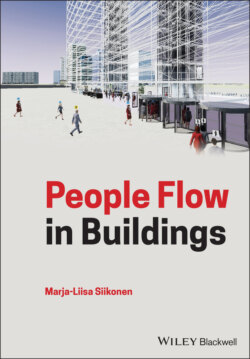Читать книгу People Flow in Buildings - Marja-Liisa Siikonen - Страница 3
На сайте Литреса книга снята с продажи.
List of Tables
Оглавление1 Chapter 1Table 1.1 Typical values for building occupation.Table 1.2 Typical occupancy factors in residential buildings.Table 1.3 Typical occupancy factors of hotel guests.Table 1.4 Typical occupancy factors in hospitals.
2 Chapter 2Table 2.1 Minimum information for counting passengers in an elevator lobby.
3 Chapter 3Table 3.1 X2 ‐test results for passenger entering through the security gates, ...Table 3.2 X2 ‐test results for passengers exiting through the security gates, o...Table 3.3 Summary of observed office, hotel and residential building daily d...Table 3.4 Mean passenger batch size distribution for different times of day.
4 Chapter 4Table 4.1 Summary of building and traffic data from the measured buildings.Table 4.2 Building occupancy and passenger trip data.Table 4.3 Average number of passenger trips occupants make within a day.Table 4.4 Average number of passengers visiting different building types.
5 Chapter 5Table 5.1 Data of the surveyed buildings with the monitoring systems.Table 5.2 Monitored service times in the five buildings.Table 5.3 Monitored number of starts of the five buildings.
6 Chapter 9Table 9.1 Maximum number of alternative elevator routes with different contr...
7 Chapter 14Table 14.1 A single‐passenger elevator dimensions with counterweight on the ...Table 14.2 Pit depths and headroom heights (ISO 8100‐30:2019).
8 Chapter 17Table 17.1 Side‐opening (SO) and centre‐opening (CO) door widths with typica...Table 17.2 Examples of time consumed in stopping in offices and hotels (ISO ...Table 17.3 Typical nominal travel time criteria for speed selection.Table 17.4 Variations of elevator flight‐time equations.Table 17.5 Flight times according to Eqs. (17.19) and (17.22) and probable j...Table 17.6 The components of the roundtrip time equation consideringr‐floor ...Table 17.7 Flight times for typical floors, tr, and over express zone, ts,exTable 17.8 Up‐peak RTT from the main entrance to 14 upper floors calculated ...Table 17.9 Additional RTT caused by the three entrance floors calculated fro...Table 17.10 Round trip times for paternoster and conventional duplex and qua...
9 Chapter 18Table 18.1 Calculated P0‐ and qw‐values for different group sizes.Table 18.2 Calculated and simulated ATT‐values for a 16‐floor building.Table 18.3 Calculated and simulated ATT‐values for a 23‐floor building.
10 Chapter 19Table 19.1 LOS definition by Fruin (1987).Table 19.2 LOS definitions for pedestrian speed on walkways.Table 19.3 Pedestrian characteristics suggested for an elevator in a resort...Table 19.4 Rated passenger capacities and loads, and car internal areas of ...Table 19.5 LOS for different car load factors.Table 19.6 Theoretical maximum (EN 115‐1 2008) for escalator handling capac...Table 19.7 k‐Values for maximum number of passengers on escalators.Table 19.8 Maximum escalator handling capacities in persons per hour.Table 19.9 Nominal observed (ASME A17.1 2013) escalator handling capacities...Table 19.10 Transportation capacities of 1000 mm (40 in)‐wide or wider movi...Table 19.11 Observed people movement characteristics in a 1400 mm‐wide and ...Table 19.12 Maximum door speed of automatic revolving doors (International ...Table 19.13 Side-opening (SO) and centre-opening (CO) elevator door widths ...Table 19.14 Pedestrian handling capacity in various types of turnstiles....Table 19.15 Handling capacities ofDOPs.
11 Chapter 21Table 21.1 Four traffic mix areas in anOD matrix.
12 Chapter 23Table 23.1 The simulated RTT frequencies,fi.
13 Chapter 24Table 24.1 Buildings and zoned elevator groups with handling capacity of 12...Table 24.2 Up‐peak handling capacities for different number of cars in the ...Table 24.3 Simulated car load factor and waiting times according to demand.Table 24.4 Relative handling capacities for three traffic mixes for differe...Table 24.5 Simulated and calculated waiting time distributions.
14 Chapter 26Table 26.1 Rated load selection based on mass from the maximum number of pe...Table 26.2 The maximum number of persons allowed in the car and average num...
15 Chapter 27Table 27.1 Design criteria for elevator selection (ISO 8100-32:2020).Table 27.2 Passenger waiting time recommendation where walking time is not ...Table 27.3 Passenger time to destination recommendation where walking time ...
16 Chapter 29Table 29.1 Use of stairs.Table 29.2 Use of escalators and elevators.
17 Chapter 30Table 30.1 Elevator core areas including elevator lobbies at the main entra...Table 30.2 Elevator core areas including elevator lobbies at the main entra...Table 30.3 Elevator main lobby areas of three sky lobby arrangements with t...Table 30.4 Elevator main lobby areas of three sky lobby arrangements with t...Table 30.5 Elevator core space demand with different elevator arrangements.
18 AppendixTable A.1 Passenger transfers through security gates in Poland.Table A.2 X2‐test data for entering passengers through the security gates on 7 J...Table A.3 X2‐test data for exiting passengers through the security gates on 7 Ja...Table A.4 Typical daily traffic profile of a multi‐tenant office building.Table A.5 Typical daily traffic profile of a single‐tenant office building.Table A.6 Typical daily traffic components of a hotel in Egypt.Table A.7 Typical daily traffic profile of a residential building.Table A.8 Typical profile for hospital visitors.
